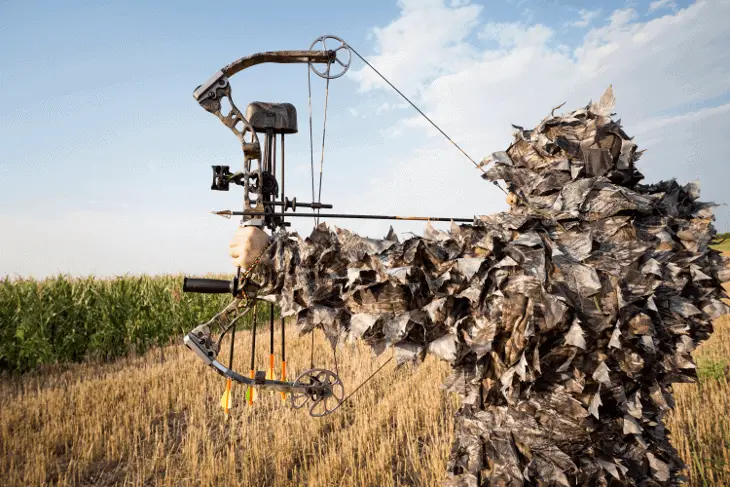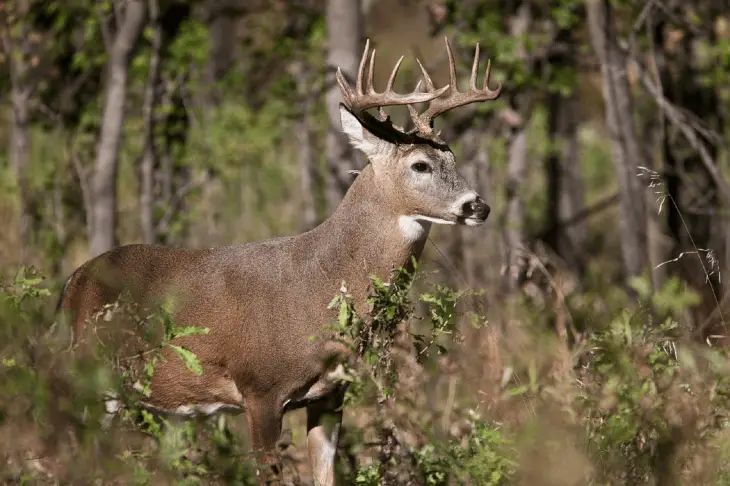Note: Our site links to archery and bowhunting products sold by outside vendors, and we may earn a small commission if you purchase an item after clicking one of these links. Learn more about our affiliate program.
Archery is a sport that can inspire lifelong passion and devotion. The best way to break into this enchanting world of archery is to start with a beginner bow that’s both fun but also helps you learn. That’s why we’ve created a guide that gives you a clear roadmap on the workings of a compound bow and provides full reviews of the best beginner compound bows of 2023.
Quick Picks: Our Favorite Compound Bows for Beginners
We are going to go into deep detail about each of the compound bows on our list, but before we get to the reviews, here is a short summary if you don’t want to read the extended version. In our opinion, these are some of the top choices for compound bows for people who are new to archery.
PSE Archery Uprising Compound Bow Package: This is our favorite overall compound bow for beginners because it’s highly adjustable so newbies can learn and improve smoothly.
Bear Archery Species EV Compound Bow Package: This is a great choice for bowhunting thanks to its high power in a model that’s still easy to learn on.
Diamond by Bowtech Edge XT Compound Bow Package: We put this on our list as another solid bowhunting option for those who need to start with low draw weight buck work up to more power.
Bear Archery Cruzer G2: This bow has made our list two years running due to its array of great bowhunting features that are good for beginners.
Bear Archery Royale Compound Bow Package: We recommend this compound bow for youth because it’s lightweight and has a highly adjustable draw weight that can grow with its archer.
PSE Archery Mini Burner Compound Bow Package: This bow is a good choice for teenagers who are interested in archery but need to learn good form.
Bear Archery Limitless Compound Bow Package: Teenagers who have a good amount of upper-body strength can benefit from this model’s full package of accessories.
Southland Archery Supply SAS Scorpii Compound Bow Package: For those interested in target shooting, this model from SAS has the right accessories to hone your aim.
TIDEWE Compound Bow: Since this bow has one of the largest ranges of adjustable draw weights on the market, it’s ideal for beginners who want to start target shooting.
Sanlida Archery Dragon X8 Compound Bow Package: This model made our list not just for its budget price but for its great specs and numerous included accessories.
Our In-Depth Reviews of the Best Compound Bows for Beginners
Now that you have read through our summaries, let’s take a shot at the in-depth compound bow reviews and purchase guides.
Best Beginner Compound Bow Overall
Before anything else, we want to give our absolute favorite compound bow for beginners in 2023.
PSE Archery Uprising Compound Bow Package
Thanks to its highly adjustable design and multiple color options, the PSE Uprising is our favorite way for new archers to get into the sport and work their way up as they learn and improve.
- Compound bow for beginners: Package offers a wide-ranging, press-free adjustment to grow with you as you learn the skills in archery; Advance your skills with an easy to maneuver compound bow
- Bow specifications: 70% Let-Off. Axle-to-Axle: 30″. Brace Height: 6 ⁵⁄₈. Mass Weight: 3.2 lbs. Draw Length Range: 14″ – 30.” Draw Weight 15-70 lbs. Limb Bolt Turns: 13. CAM: UP
- A great hunting bow: The UPRISING is part of PSE’s Adapt Series; Versatile, with easy adjusting, a complete high performance hunting bow
Pros:
- Draw weight adjustable from 15-70 lbs
- 70% let-off
- Draw length adjustable from 14-30 inches
- Complete shooting kit
- 5-arrow quiver included
- 3 color options including camo
Cons:
- Nothing!
If you’re looking to get into compound archery this year, our top recommendation is the PSE Uprising. The biggest reason is the huge range of draw weights. It’s adjustable from 15 lbs all the way to 70 lbs. This way you can start out with something manageable but work your way up to considerable power, more than you’ll find on a lot of compound models.
Additionally, the let-off is 70 percent, which makes it much more accessible for beginners. Basically, this means that if you have it set to 20 lbs of draw weight, for instance, you only have to hold four pounds at full draw. That’s easy to hold steady, even if your shoulder muscles aren’t quite used to shooting yet.
On top of the draw weight, you can also adjust the draw length. It has a big range, too: 14 inches to 30 inches. This means it’s good for people of all sizes, including youth who may just be getting into archery.
Finally, the Uprising is ideal for beginners because it’s a ready-to-shoot kit. You get a number of accessories including a pin sight, arrow rest, and even a stabilizer. Best of all, the kit comes with a quiver with room for five arrows. That’s important because as a beginner, you’re bound to lose a couple.
Best Beginner Compound Bows for Hunting
Of course, many people start looking into compound bows specifically because of their high power and accuracy, which makes them good for bowhunting, even without a ton of archery practice. Plus, archery hunting seasons are usually longer than rifle seasons, so it allows you to hunt more of the year.
If you’re new to compound bows but want to hit the tree stand with one as soon as possible, these are our top recommendations.
Bear Archery Species EV Compound Bow Package
For those anxious to get out into the woods and start hunting game like whitetail deer, the Bear Archery Species EV has a lot of power and accuracy in a lightweight frame that’s easy to learn on in the field.
- Widely accommodating with a 23.5″ to 30.5″ draw length
- A newly designed single cam system raises the let off to a class leading 80%
- RTH package includes a Trophy Ridge Joker 4-pin sight, 5-Spot quiver, Whisker Biscuit V, Blitz stabilizer and wrist sling, peep sight, and D-loop
Pros:
- 80% let-off
- 2 draw weight options
- 320 fps arrow speed
- Lightweight
- Whisker Biscuit rest
- Hunting accessories included
Cons:
- Not highly adjustable
The main reason the Species EV is a great bowhunting model is its high let-off of 80 percent, one of the highest on the market. This way, you can still get enough power to take down game like whitetail deer without dealing with a draw weight that’s hard for a beginner to hold and aim.
As for the gross draw weight, it is adjustable, though not by much. Instead, you choose between two options: 45-60 lbs or 55-70 lbs. Unless you have a lot of upper-body strength, we’d recommend the lighter option. With 80-percent let-off, 45 lbs of draw weight means you have to hold nine pounds at full draw, not bad for most adults. Then, you can work your way up.
To get a good idea of this bow’s power, consider that the rated arrow speed is 320 fps, though that’s only with maximum draw weight. Nevertheless, this gives you good range to shoot game accurately, especially from a tree stand. At the same time, it’s not too fast for a beginner to practice with and learn.
One thing that really impressed us about the Species EV is that despite its power, it’s lightweight at just 3.8 lbs. Because you may have to hold the bow steady while aiming as you wait for a quarry to move into position, this lightweight design is a big advantage, especially for beginners who may not be used to holding bows up with a straight arm for long periods of time.
Lastly, we liked that the kit comes with accessories that are specific to hunting needs. For example, you get a Whisker Biscuit rest, one of the best types of rests for accuracy because it keeps the arrow’s trajectory straight out of the bow.
Diamond by Bowtech Edge XT Compound Bow Package
If you have no experience with archery whatsoever but want to get into bowhunting, we suggest the Diamond Edge XT because it’s lightweight and has an adjustable draw weight so you can practice and then work your way up to hunting power.
- FULLY ACCESSORIZED – The Diamond Edge XT bow package includes accessories: Octane Furnace 4-Arrow Quiver, 3 Pin Sight, 5 Inch Stabilizer, Brush Rest, Standard Peep, Diamond Wrist Strap; NOTE: bowstring has string separator for peep sight installation
- STABILITY & ACCURACY – The strategically engineered caged riser and quad limb design create enhanced riser rigidity and ultimate stability at full draw for shot-to-shot consistent premium accuracy that no other bow at this price can provide
- EXTREME ADJUSTABILITY – With the Edge XT you can remove the module screws and adjust the draw length anywhere from 19 to 31inches, re-tighten and you are set – no separate modules or cams are needed
Pros:
- Super lightweight
- Adjustable draw weight
- Included hunting accessories
- Brush arrow rest
- Various camo options
Cons:
- Low arrow speed
- Flimsy draw length modules
Like the Species, we like the Diamond Edge XT for hunting in part because it’s so lightweight. In fact, it’s slightly lighter at 3.7 pounds. Again, this is great since you can hold it steady for longer. This helps you maintain your aim as you wait for your quarry to turn to the right angle or come into range.
That’s not all, though. We also love how adjustable this model is. It can go all the way up to 70 lbs of draw weight, definitely enough for hunting big game. However, if you’re a beginner who isn’t ready to hit the tree stand just yet, you can tune it down to 20 lbs and practice first. It’s not the fastest model on the market, but at 300 fps, it’s fine for hunting, you just might have a smaller range.
The included accessories are good for hunting as well. The brush rest improves accuracy by interfering less with the trajectory of the arrow. We especially like the pin sight that includes a level and helps you hit the kill zone from multiple different ranges.
Last but not least, if you want to get into bowhunting, you’ll need a camo bow. With the Edge XT, you have three different camo patterns in addition to plain black so that you match the environment you plan to hunt in.
Bear Archery Cruzer G2
Our top overall last year, we couldn’t leave the Bear Archery Cruzer G2 off our 2023 list, especially considering its hunting features like a good arrow speed, adjustable draw weight and Whisker Biscuit rest.
- VERSATILE: Maximum-versatility bow is engineered for all ages and skill levels
- READY TO HUNT: Ready to hunt bow comes equipped with six Trophy Ridge accessories
- ADJUSTABLE: Adjustable from 12″ to 30″ draw length range and from 5 to 70 lbs. peak draw weight
Pros:
- Budget-friendly
- Easily adjustable
- Sturdy and durable
- A diverse range of accessories are available
- Whisker Biscuit rest
Cons:
- Not suitable for tall people
The Bear Archery Cruzer G2 is a highly versatile compound bow that is also extremely powerful. When it comes to compound bows, Bear is one of the biggest names around. The founder has been making bows for almost 100 years and the construction and performance is a testament to their quality.
It has a solid FPS of 315 which is also paired with a low physical weight of just 3 pounds. This makes it a beginner-friendly bow for hunting that is also a solid pick for those who have been in the field of archery for a while. It easily adapts to increasing skill levels which is a bonus for those looking for a compound bow that can grow with their skill level.
It has a draw length of 12 to 30 inches which will fit the average person, though maybe not the especially tall. The let-off is a bit lower than some other models clocking in at just 70%, but if you’re an adult with average to strong arms, this won’t be a problem. The draw weight ranges are wide enough that a new archer will be able to adjust as they grow without getting frustrated.
The full kit has some add-ons that you can fit that will make your experience even better. A quiver that holds several bows and can attach to the rider will keep you well-stocked during practice. The fixed pin sight allows you to sight at least four targets at varied ranges. The wicker biscuit arrow rest is another favorite of ours that you will find on this model.
Best Beginner Compound Bows for Youth
Many people begin archery when they’re young, as teenagers or even older children. In fact, USA Archery recommends starting as young as eight years old. Nonetheless, youth have specific needs when it comes to their first compound bow like lightweight and manageable power. These are our top recommendations.
Bear Archery Royale Compound Bow Package
The lightweight construction and low but adjustable draw weight make the Bear Archery Royale a solid beginner bow for young archers excited to get into a new sport.
- VERSATILE: Extremely versatile bow that can be easily adjusted
- ADJUSTABLE: Adjustable from 12 to 27 inches in draw length and from 5 to 50 lbs. peak draw weight
- READY TO HUNT: Ready to hunt bow comes equipped with Trophy Ridge and Fletcher Archery accessories
Pros:
- Reliable brand name
- Draw weight adjustable 5-50 lbs
- 75% let-off
- 290 fps arrow speed
- Camo options
- Lightweight
Cons:
- May require some tweaking
- Draw length short for older teenagers
It should be pretty clear from this list that we like the Bear Archery brand. They make durable, quality bows and hold up to repeated shooting, even if you’re a beginner whose form isn’t 100 percent yet.
The biggest thing that makes this bow good for beginners is the low and adjustable draw weight. You can adjust it all the way down to just five pounds. Combine that with the impressive 75-percent let-off, and you’d have an effective draw weight of just over a pound. Nearly anyone can hold that steady as they work on their form.
At the other end of the spectrum, you can turn it all the way up to 50 lbs, which will also give you up to 290 fps of arrow speed. This allows a youth to practice serious archery and prepare for an adult bow, plus, combined with the camo options, you can even use it for bowhunting.
Like the draw weight, the draw length is also adjustable between 12 and 27 inches. That’s great for older children because you can increase the length as their arms grow. Nevertheless, it might be too short for a teenage archer, especially if they’re a boy who’s already fully grown.
Last of all, it’s good for youth because it’s lightweight. Weighing just 2.7 pounds, it’s much easier for someone who hasn’t developed upper-body strength to hold steady while they adjust their form and aim.
PSE Archery Mini Burner Compound Bow Package
The PSE Mini Burner is our recommendation for teenagers who may already have some upper-body strength but still need a lower draw weight so they can practice their aim and form.
- PACKAGE INCLUDES: 3 Pin Sight, Arrow Rest, 5-Arrow Quiver, 6” Stabilizer, 3-Carbon Arrows
- Axle to Axle: 26″; Brace Height: 6 5/8″
- Draw Length Range: 16″ to 26-1/2″
Pros:
- Mid-range draw weights of 29 or 40 lbs
- 310 fps arrow speed
- 70% let-off
- Pin sight included
- 5-arrow quiver
Cons:
- Short draw length
- Draw weight not adjustable
The PSE Mini Burner has a mid-range draw weight. While it isn’t as adjustable as other models with choices of either 29 or 40 lbs, this is a draw weight that’s manageable for teenage beginners while still providing enough power for serious archery applications. In fact, you can get up to 310 fps of arrow speed.
Now, it does have a let-off of 70 percent. If you get the 40-lb draw weight, this means you have to hold 12 pounds at full draw. That’s not too bad, but it’s best for someone who already has a little upper-body strength.
The best thing for beginners about this bow, though, is probably the full shooting kit. It includes three high-quality, durable carbon arrows and a stabilizer. Plus, it has a three-pin sight for accuracy at up to three different ranges and a five-arrow quiver.
Bear Archery Limitless Compound Bow Package
The Bear Archery Limitless is our top pick for youth archers who are a bit older and have the upper-body strength to start practicing with more draw weight.
- Dual cam system packs a powerful punch at 265 feet per second
- Highly-adjustable from 19″-29″ in draw length and 25-50 lbs. in draw weight
- Ready to hunt bow comes equipped with Trophy Ridge sight, Trophy Ridge Whisker Biscuit, Bear 3 Arrow Quiver, peep sight, nock loop
Pros:
- Durable dual cam system
- Adjustable draw weight from 25-50 lbs
- Adjustable draw length from 19-29 inches
- Included hunting accessories
- Whisker Biscuit rest
- Optional targets
Cons:
- Low arrow speed
- Heavy for youth bow
- Small draw weight range
Our favorite feature of the Bear Archery Limitless is the well-constructed dual cam system. It remains consistent and reliable, important for a beginner who may not know how to perform compound bow maintenance or want to pay for regular trips to the shop.
Furthermore, the Limitless has an adjustable draw weight, though the range is just 25-50 lbs. Since the draw length is adjustable up to 29 inches, this makes it good for fully grown teenagers who are just getting into archery or bowhunting. We were a bit disappointed that with this draw weight, you only get 265 fps of arrow speed, but this could potentially be enough for hunting small deer, though your range may be limited.
This is another full kit. Specifically, it’s ready for bowhunting with accessories like a pin sight and a Whisker Biscuit rest that really improves accuracy. However, what’s better than a lot of other kits is that you can optionally include certain accessories like a release aid or even a target. Adding a target to the package can really help a beginner learn aiming and accuracy.
Best Beginner Compound Bows for Target Shooting
Although bowhunting tends to dominate the compound bow market, target shooting with compound bows is also a lot of fun, especially since compound bows get high bow speeds that allow for accurate, long-distance shots. If you want to start target shooting with a compound bow, we suggest one of these two.
Southland Archery Supply SAS Scorpii Compound Bow Package
The SAS Scorpii starts you off on the right foot target shooting because you can include tons of accessories in your packages including things like a stabilizer, case and arrows so you can practice effectively at the range.
- Draw Length: Adjustable from 19″ – 29”
- Draw Weight: 11-55 lbs.
- Axle to Axle: 28″
Pros:
- Optional shooting accessories
- Package with case and 12 arrows
- Draw weight adjustable 11-55 lbs
- Draw length adjustable 19-29 inches
- 296 fps arrow speed
Cons:
- Including accessories raises the price
- Low let-off
For target shooting, we specifically recommend the Scorpii with the optional travel package. This is because you get an aluminum stabilizer, release aid, and five-pin sight, among other accessories. These accessories in particular can help you improve your archery quickly so you can start competing.
Speaking of competing, the travel package is great because it includes a hard case so you can carry your bow safely to the range or meets. Plus, it even comes with 12 carbon arrows. Having a lot of arrows is good for practice because you don’t have to constantly walk to the end of the range to retrieve them. You can spend more time shooting.
As for specs, the Scorpii has a good range for beginners, starting as low as 11 lbs but adjustable up to 55 lbs. The draw length is then adjustable from 19-29 inches. This provides you an arrow speed of 296 fps, enough to go bowhunting as well if you so decide.
TIDEWE Compound Bow
Few compound bows are as adjustable as the Tidewe, which makes an ideal model for beginner target shooters who want to start light but work their way up. Plus, it comes with tons of accessories.
- 【Adjustable & Extensive Application】 The draw length ranges from 18’’-31’’, and the draw weight can be adjusted from 0 lb – 70 lbs without needing a bow press. The TIDEWE compound bow is for men, women, youth, beginners and professionals. Perfect for hunting, training etc.
- 【Premium Quality Material】 The high speed bow string and cables are BCY, imported from BCY USA. The bow limbs are sturdy and are made by Gordon in the USA. Both the cams and modules are CNC machined with the 6061 aluminum, to provide safety and durability, as well as abrasion resistance.
- 【Notice】 Please read the user manual carefully before using the compound bow. DO NOT dry fire (shooting the bow without an arrow)! As it will damage the bow and could cause serious bodily harm to the shooter. We recommend teenagers be accompanied by adults during use.
Pros:
- Highly adjustable draw weight 0-70 lbs
- Adjustable draw length 18-31 inches
- 315 fps arrow speed
- Let-off up to 80%
- Important target-shooting accessories included
Cons:
- Assembly required
- A little heavy
There’s a lot to love about the Tidewe compound bow. The specs are awesome, especially for a model in this price range. With a huge range of adjustable draw weight from 0-70 lbs, you can get a maximum of 315 fps of arrow speed that provides for on-target shots. Plus, the draw length is adjustable from 18-31 inches, making it good for shorter and taller target shooters alike.
Despite the high power, this Tidewe model is easy to handle because it has a let-off of up to 80 percent. This allows you to progress easily up the draw weights up and maintain your accuracy and form as you do.
Finally, Tidewe includes a lot of accessories you need for target shooting. For instance, you get a five-pin target sight that allows you to practice from different distances and on different ranges. Plus, you get a stabilizer and release, necessary accessories for consistent shots. You even get six carbon arrows.
Best Beginner Compound Bow on a Budget
As a beginner, you may understandably want to get a bow in a lower price range. After all, you may decide you don’t like archery as much as you thought you would or you may want to move up to a more advanced bow after you build some skills. If you want a quality bow that’s easy on your wallet, check out this model.
Sanlida Archery Dragon X8 Compound Bow Package
If you’re itching to get into archery but are on a budget, we highly recommend the Sanlida Dragon X8 for its great specs and numerous accessories, all at a value price.
- Ready to hunt compound bow pro package comes with a 5-pin sight, an arrow rest and a stabilizer, a wrist sling, a peep sight, 12 pcs of arrows, a quiver, a release, an arrow puller, a bow stand and a compound bow case.
- Large range of adjustable draw length 18-31″, draw weight 0 -70 lbs without needing a bow press. A bow for all ages and skill levels. Limited Life-time Warranty on main parts after your registration within 30 days of purchase.
- Specifications: Axle-to-Axle 30″, Brace Height 6.6″, Draw Weight 0 to 70 LBS, Draw Length 18″ to 31″,(Each 0.5″ adjustment), IBO Speed 310FPS, Net Weight 3.8 LBS, String Length 58.13″ , Cable Length 32.23″. For the extra replacement string and cables, B091291VDQ is for the Dragon X8 compound bow.
Pros:
- Extensive accessories included
- Adjustable draw weight 0-70 lbs
- Adjustable draw length 18-31 inches
- 310 fps arrow speed
- Limited lifetime warranty
Cons:
- Less accurate at high speeds
- Requires some tuning
First and foremost, consider that even though the Dragon X8 comes at a super low price point, it’s a full package with a lot of included accessories. Not only do you get a stabilizer and sight, but you get accessories not included in other packages like a carrying case and 12 arrows.
The specs are great for the price as well. An adjustable draw weight from 0-70 lbs lets you use it in all sorts of applications, regardless of your exact skill level or rate of learning. The adjustable draw length of 18-31 inches makes it a good fit for most sizes as well as youth who are still growing. Altogether, this gives you a maximum arrow speed of 310 fps.
One other thing we want to mention is the limited lifetime warranty. You may be worried about the quality of a budget model, so this warranty lets you buy with a bit more confidence.
How to Choose the Right-Sized Compound
Before we get into our compound bow reviews, it is important to understand how to chose a bow that is sized to meet your personal needs. Aesthetics play an important role in purchase decisions, but when it comes to compound bows, there is more to a perfect fit than how the bow looks. We have put together an easy-to-understand guide on factors that you should keep in mind when choosing a compound bow as a beginner archer.
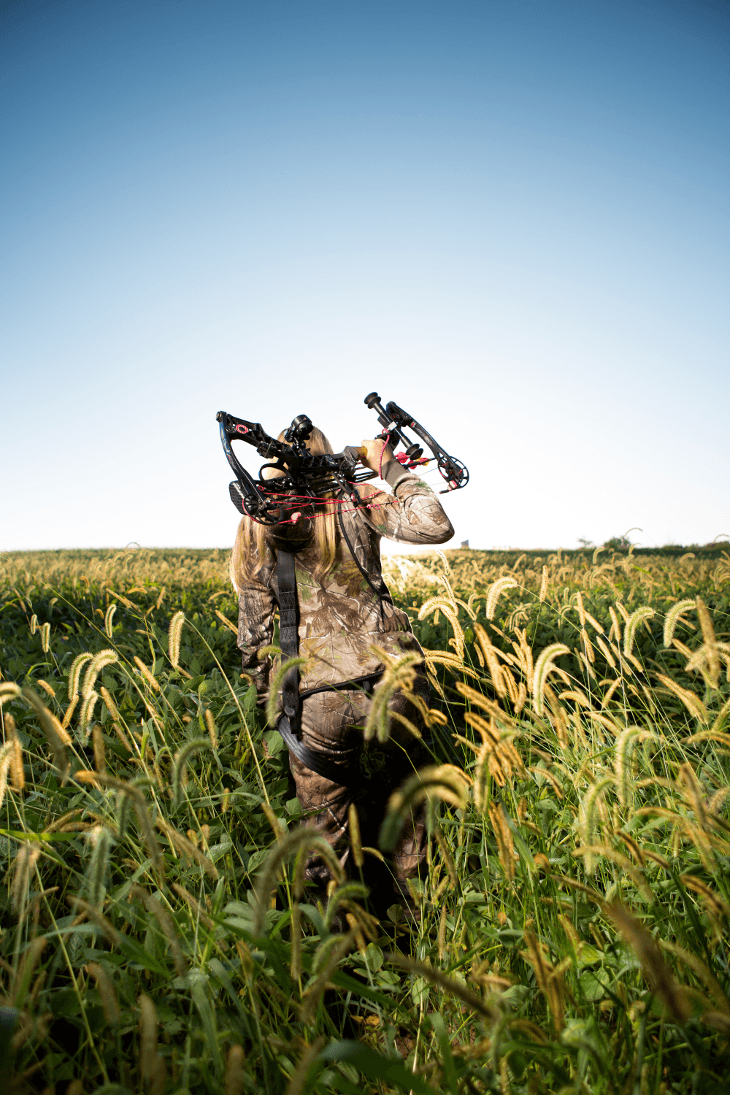
Find Your Correct Draw Length
“Draw length” refers to how far you can pull a bow string back towards you when you’re holding a bow. It’s a very important measurement to take, and it’s one of the vital measurements you’ll need to take before you purchase a bow.
To measure your draw length, stand up with your back straight and stretch both arms out to your sides. You should look like a “T.” Keep your hands flat and fully extended—no fists.
Measure, in inches, from the end of your middle finger on one hand, all the way to the end of your middle finger on the opposite hand. Next, divide that number by 2.5, and that’ll give you an approximation of your draw length.
Here’s an example: let’s say you’re 5’ 10” (which is the average height of an American male). If you stretched your arms out against the wall, you’d find that you’re 70 inches long (5 feet x 12 inches per foot + 10 inches = 70 inches). 70 inches / 2.5 = a 28-inch draw length.
Here’s why draw length is so important: bows are specifically designed for people with exact draw lengths. People with longer draw lengths will shoot best with larger bow, and people with a smaller draw length will shoot best with a smaller bow. When you look at bows you’re interested in, make sure they’re available within your draw length, because take it from us—shooting a bow with the wrong draw length is both frustrating and dangerous!
Find Your Correct Draw Weight
Draw weight, basically, is how much force it will take you pull the string back. A bow with a lower draw weight—say, 15 pounds—will be a lot easier to draw than a bow with a higher draw weight—say, of 65 pounds. Lighter bows are easier to draw back, but they shoot arrows more slowly, whereas heavy bows are hard to draw back, but they shoot arrows at greater force and speed.
Ideally, you want to find a bow that’s in your “Goldilocks” zone—one that’s not too light and not too heavy.
When choosing a draw weight, it’s usually a good idea to go lighter, rather than heavier, especially if you’re new to archery. Your muscles will develop over time and with practice, at which point you can switch to a heavier bow. Everyone is able to handle different amounts of weight, but as a general rule of thumb, here are some guidelines for recommended draw weight:
Men and women between the ages of 18 and 21: draw weight between 15 and 30 pounds (with 20 or 25 pounds a reasonable starting point)
Women age 22 and above: draw weight between 20 and 35 pounds (with 25 or 30 pounds a reasonable starting point)
Men age 22 and above: draw weight between 25 and 40 pounds (with 30 or 35 pounds a reasonable starting point).
If you consider yourself particularly strong, you may want to go slightly above these weights, but—be careful! Being “over-bowed” is a thing that happens to a LOT of people, it’s not like lifting a weight once. If you have a 40-pound bow, every time you draw it’s like lifting 40 pounds. It gets tiring. Better to start low and build.
Find the Correct Bow Length
Bow length is sometimes called the axle-to-axle length. The length of your bow depends more on the type of shooting you do than your overall size. Shorter compound bows are usually recommended for hunters, for example—it’s easier to go through woods and brush with a shorter bow—whereas longer compound bows are usually a good match for target archers and 3-D aficionados. There are, of course, exceptions to every rule, and you might find that you prefer a long bow for hunting or a short bow for target practice. Bow length is usually a little more important to archers using a recurve bow, and you have more options when you use a compound.
Figure Out Your Dominant Eye
In the same way that we’re all either left-handed or right-handed, we’re also right-eyed or left-eyed. One of our eyes focuses more strongly than other, and that’s our dominant eye, and it’s another important thing to keep in mind when you’re looking for a bow.
Usually, the dominant eye is the same as the dominant hand, but that’s not always the case—so you’ll need to figure out which eye is your dominant eye. Here’s how you do it: stretch both arms out in front of you. Form a triangle shape with your two thumbs and index fingers pressed together, like this. Find something to place in the middle of the triangle, such as a spot on a wall, or a doorknob, or something like that.
Now look through the triangle with both eyes open. Now, close one eye. Open that eye and close the other eye. If you’re doing this correctly, you should see the spot or the doorknob with one eye, and not the other. The eye you can see it with is your dominant eye.
When you’re buying a bow, if you’re right eye dominant, choose a right-handed bow. If you’re left eye dominant, choose a left-handed bow.
But… what happens if your dominant eye and your dominant hand don’t match up? If you’re right-handed, but left-eye dominant, or left-handed, but right-eye dominant?
That actually happens quite frequently, and that’s called “cross dominance.” If you’re cross-dominant, you have a choice to make: you can choose a bow that matches your handed-ness (which will feel a lot more comfortable, but it’ll be harder to aim), or you can choose a bow that matches your dominant eye (which will feel very odd, like writing on paper with your non-dominant hand—but easier to aim).
Most cross-dominant people choose a bow that goes with their handedness (lefties get a left-handed bow, righties get a right-handed bow), because that feels easiest, and they’re able to aim using a scope—but it’s up to you. There’s actually a lot of debate about that, and you can read more about it here.
And… there you have it! Those are the most important measurements you’ll need when selecting a bow.
Now that you know all that, it also helps to know and understand…
The Parts of a Compound Bow, In Detail
In our humble opinion, the best way to learn about compound bows is to study their parts. Once you have an understanding of each part, why it’s important, and how it’s used, you’ll have a better understanding of the bow, and how to use it accurately. Archery is a sport of knowledge, and very often, knowledge = ability.
Compound bows have considerably more parts compared to their cousins, the recurve bow (and their second cousins, the longbow). Knowing the different parts of a compound—and the purpose of each part—will help you wisely choose your first compound bow, but it will also help you get a sense of how to use the bow properly. We’ll start with…
The Riser
Every part of the bow is incredibly important, but the riser is, perhaps, the primary part of the compound bow. Once upon a time, it was made from aluminum, but newer (and higher-end) models tend to be made from carbon fibers or a carbon/aluminum mix. The riser needs to be sturdy, because the bow experiences incredible pressure when it’s at full draw, but it also needs to be light, so that archers can lift it and shoot it again and again. Below, we’ve added a blue line that shows the entire length of the riser:
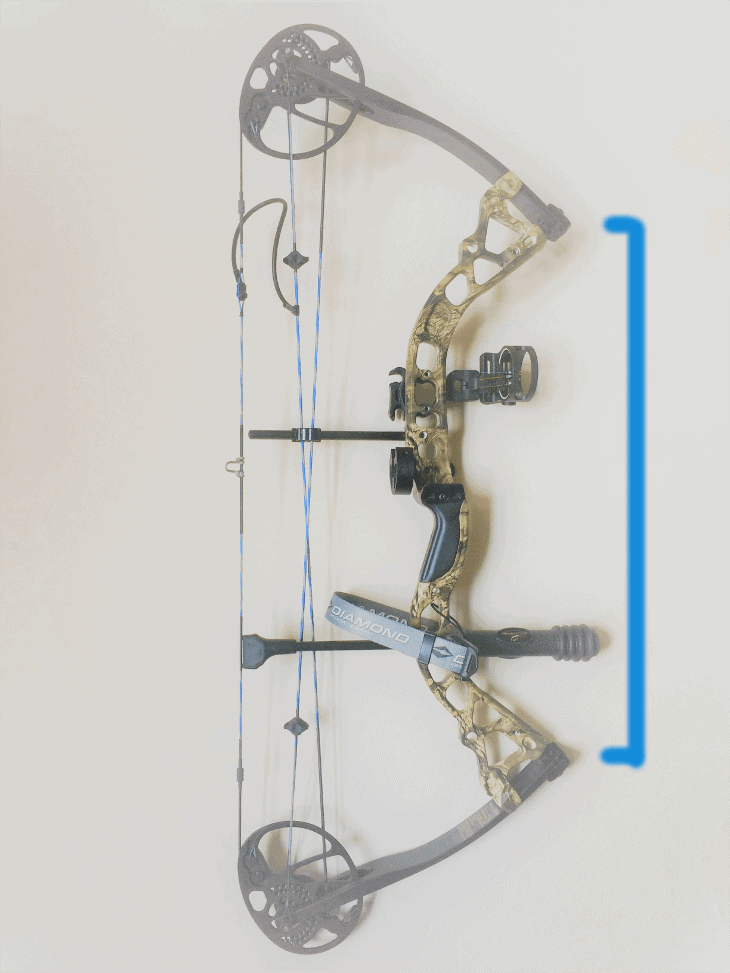
Most of the other parts of the compound bow attach to the riser, and you see that the grip, arrow rest, sight, stabilizer, limbs, etc. are all attached to the riser.
The Limbs
The limbs on a compound bow attach to, and stick out from, the top and bottom of the riser. They’re incredibly important because they hold the bow string, but also because they store a great deal of the potential energy when the bow is at full draw. Just like the riser, they need to be both light and very strong. We’ve added blue lines to show both the top and bottom limbs:
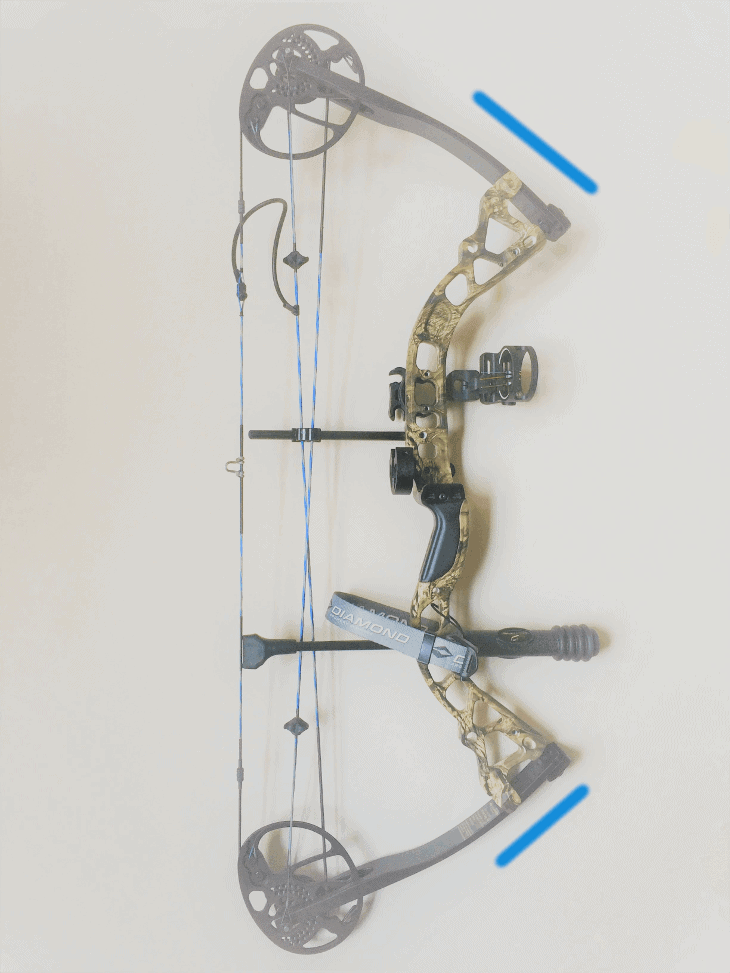
When choosing a compound bow, there are a few different styles of limb you can choose. Solid limbs are made of a single piece of material, usually fiberglass, and they’re a little “old school.” Split limbs are made of two pieces of material that connect at the riser. Often, split limbs are more durable than solid limbs and tend to be a little bit stronger, although that may not matter too much if you’re brand new to shooting.
The limbs can also be parallel, which means that they run parallel (or almost parallel) to each other across the top and bottom of the bow. Parallel limbs don’t produce as much recoil as traditional “D-shaped” limbs, and they tend to operate a bit more quietly, and those two features make parallel limbs a great choice for bowhunters, for whom silence is a big, big deal (you don’t want to scare those deer!).
The Cams
The cams are the wheels or discs that are located at the ends of the limbs on the top and bottom of the compound bow. They are the defining feature of a compound bow, and only compound bows have cams. If it doesn’t have cams, it’s not a compound bow.
Cams help to make it easier for you to pull the bowstring back, as the wheels accept much of the weight of the string, and that means you can more easily pull back on the string than you would when using a longbow or recurve bow. The cams make it easier to pull the bowstring back through basic physics, and the use of a pulley system.
A pulley is a device that allows us to lift an incredible amount of weight, and the pulley system on a compound—the cams—allow us to pull back a bowstring that might otherwise be waaaaaay too heavy to draw. A heavier bowstring allows an archer to shot arrows faster and further, and “faster and further” is something that most archers—particularly most bowhunters—want. We’ve added blue circles around the top and bottom cams:
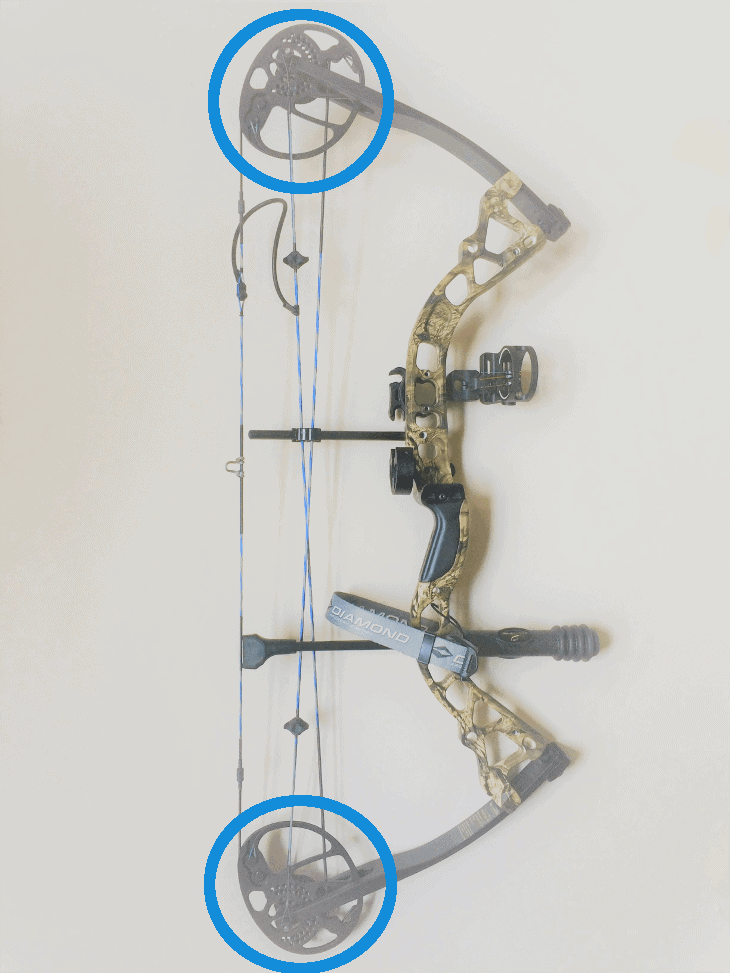
You’ll find a variety of different styles of cams on different compound bows, and the type of cams you choose usually depends on your goal as an archer. For example, round wheel cams tend to provide a bit more accuracy than other styles, while hard oval-shaped cams can shoot faster than other forms but might be trickier to set up and shoot with accuracy.
(By the way—fun fact: archery has been around for tens of thousands of years, but compound bows—and the use of cams—is relatively new. A man named Holless Wilbur Allen—a genius if there ever was one—invented the compound bow in the 1960s, and changed the sport of archery forever. The 1960s may seem like a long time ago, but in “archery years,” it’s actually very new! Alright, anyway…)
Cam Systems
So you know that there are different types of cams; a “cam system” refers to the “pairing” of cams your bow has. There are:
Single Cam Systems. Many beginner compound bows feature a single cam system, which consists of a round idler wheel at the top limb of the bow, and an elliptical cam (that is, an oval-shaped cam) at the bottom limb of the bow. Single cam systems require less maintenance than most other options and they’re easier to set up, and that’s a big plus for a new archer using a compound.
Twin Cam Systems. Twin cams (sometimes called “dual cams”) feature two cams—one on the top limb, and one on the bottom—that are perfectly symmetrical. They may be round wheels or they may be elliptical, but they match each other perfectly. The twin cam system provides a little extra speed and accuracy.
When setting up a twin cam system, the bow manufacturer needs to make sure that the cams are synchronized, and moving at the same rate. If you take your bow to the shop for a tune-up, that’s probably one of the things the tech guy will look at.
Hybrid Cam Systems. Hybrid cams feature two elliptical cams, but the elliptical cams are shaped juuuuust a little bit differently. Usually, the top cam is a “control” cam that provides the stability to the string, and a “power” cam on the bottom, the provides a little extra “ooomph” and makes the arrow travel faster.
Binary, Quad, Hinged, etc. There are other types of cams, but honestly, they get pretty complicated, so we’ll save them for another post.
If you’re new to archery, a single cam system is usually a great choice. The twin cam and hybrid cam systems you’ll find on higher-end bows can be tricky to maintain, and when something goes wrong, they can be a bear to fix.
By the way, you may be wondering: what’s the benefit of an elliptical cam? Why aren’t all cams perfectly round? The answer has to do with something called “let-off”—a really cool feature of compound bows—and we’ll discuss that a little later.
The Bowstring
This one is easy: the bowstring is the cord attached to the top and bottom limb that you nock an arrow to and pull back on. It’s what helps you launch the arrow from your bow. Modern bowstrings are usually made from synthetic materials, which are less likely to lose their shape and tension with repeated use, and you’ll occasionally need to wax them in order to keep them strong and safe.
The Cables
If you look closely, you’ll see that the cables on a compound bow aren’t the same as the bowstring. While the bowstring comes into contact with your arrow, the cables don’t. Instead, they stretch from cam to cam. When you pull back on the bowstring, the cables turn the cams. We’ve added a blue dot below to where the cable strings meet:
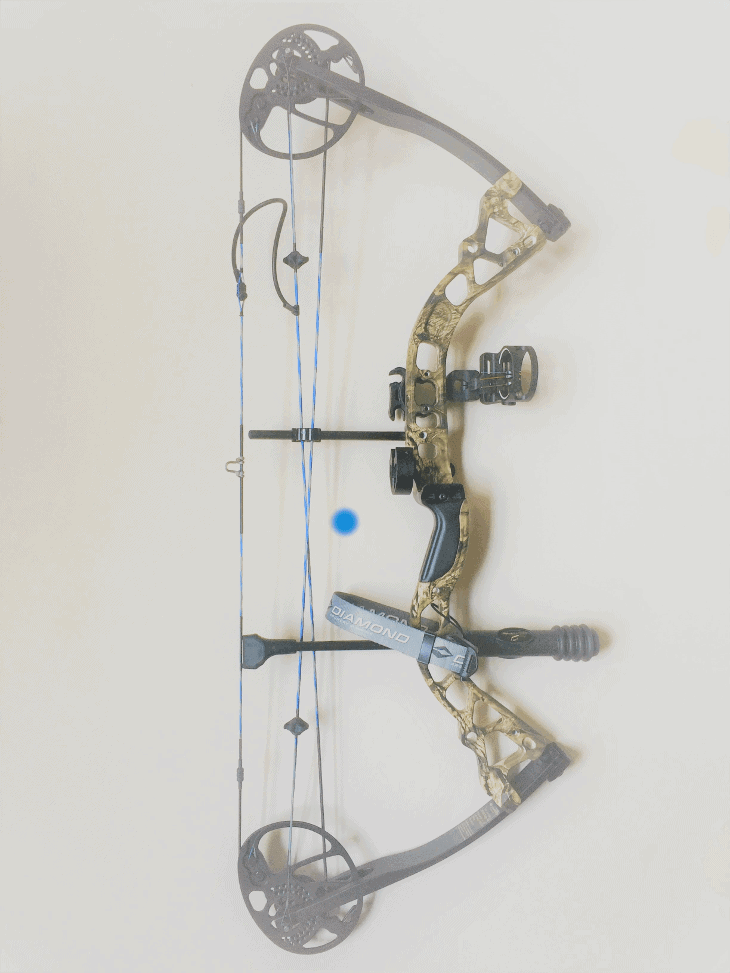
The cables are a unique part of a compound bow—they’re part of the pulley system that allows it to fire off arrows at such high speeds and with such great force, and many bows come with cables pre-installed. If you’re new to archery, we’d advise you not to mess with these—bring it to a bow tech at your range or local outfitter, and they can take a look for you.
The Cable Guard
The cable guard extends at a 90-degree angle from the riser. It’s a small rod that keeps the cables from getting in the way of the arrow and the bow string. The cable guard works with the cable slide.
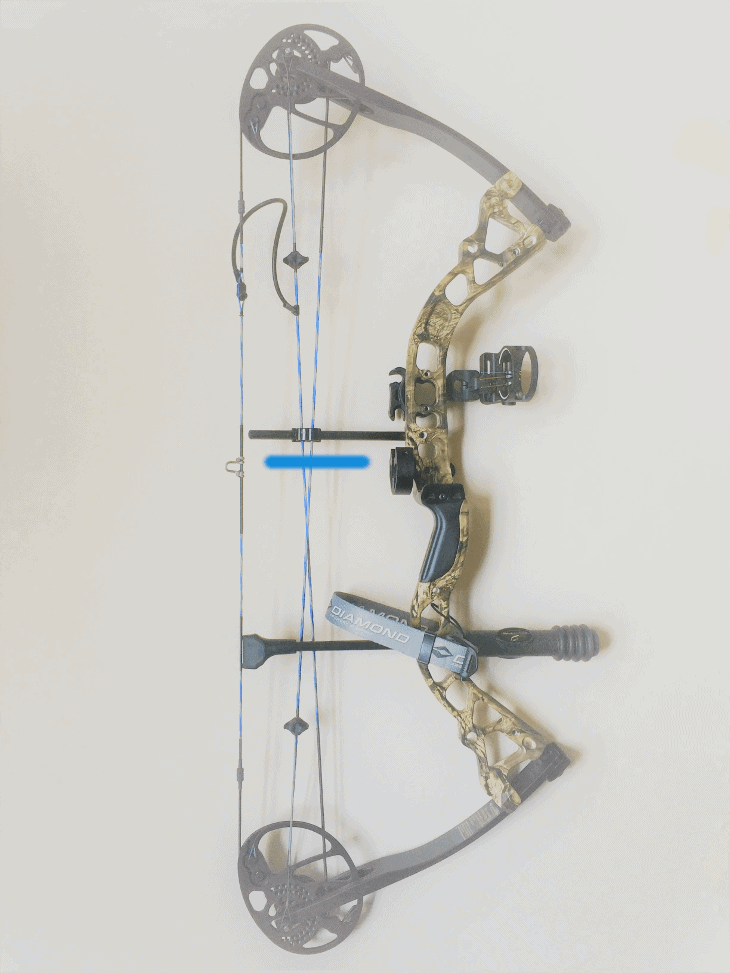
The Cable Slide
The cable slide is a small piece of plastic that attaches to the cable guard and securely holds the cables in place, out of the range of the arrow.
The Arrow Rest
The arrow rest holds the arrow in place as you set up your shot, and in some cases, it stabilizes the arrow after you’ve released the bow string and the arrow is about to leave the bow.
There are a couple of different styles of arrow rest available for compound bows, but there are two that are the most popular:
Capture Rests (aka Containment Rests). A containment rest is a circular device that surrounds the shaft of the arrow. Some, like the one in the photo below, use hard bristles to keep the arrow in place, and when the arrow is shot, the fletching on the arrows passes between those bristles. One of the most popular types of capture rests is called a “whisker biscuit,” and it’s similar to the rest shown below, but instead of three sets of hard bristles, it features soft hairs that keep the arrow in place, but allow the fletchings to pass through the hairs. Capture rests are great for hunters, because they allow the hunter to aim the bow at a target from odd angles, and not have to worry about their arrows falling off their bows. Here’s an imagine from behind the bow, that shows the containment rest:
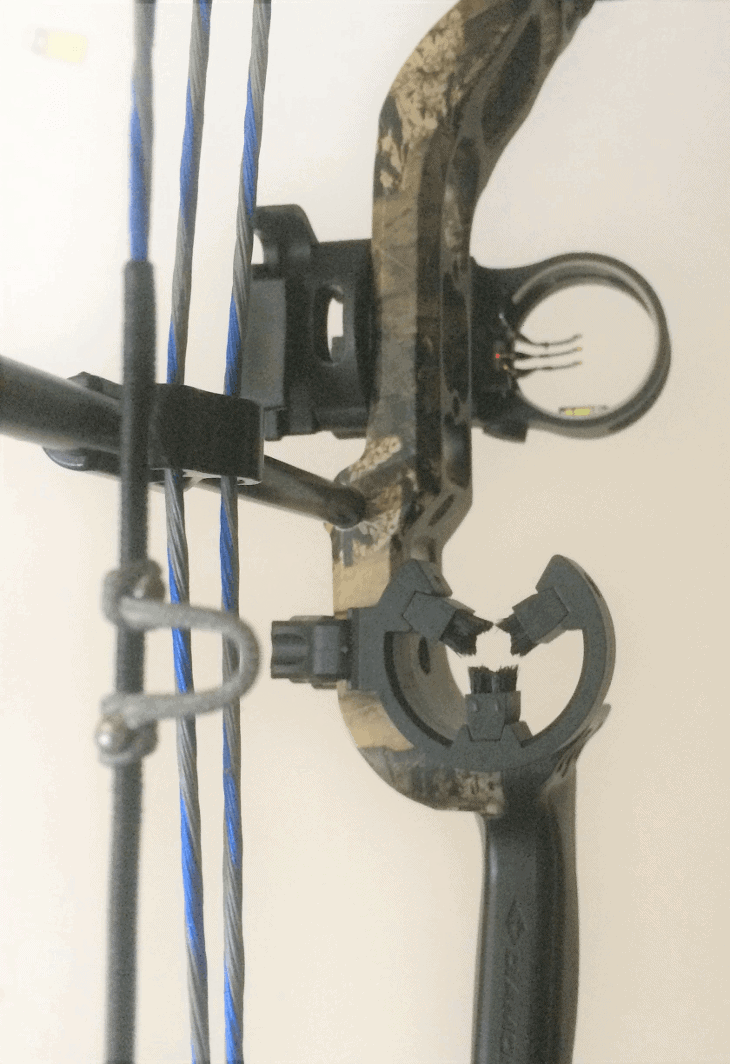
Drop-Away Arrow Rests. Another style is a drop-away arrow rest, which holds the arrow up while the archer draws the bow, and then falls away from the arrow after you release your shot. Drop-away rests are usually attached to one of the bow limbs or the cable, so that when the archer draws the bow, the rest stands up, but when the archer releases the bow string, the arrow rest “drops away.” It’s pretty clever, and if you look on YouTube, there are plenty of slow-motion videos that show how these work. These rests are popular because unlike capture rests, they don’t touch the arrow in any way. Some archers like that, even though capture rests, when used properly, can be very accurate.
A Grip
The grip is the part of the bow that you hold in your hand. Modern compound bows often have ergonomically shaped grips, which make it much more comfortable for you to grasp the bow. You can also add comfort padding or other accessories to your bow’s grip after purchase.
The Bow Sight
The sight is a tool that will help you aim at your target. It’s similar to the sight on a rifle, except instead of “crosshairs,” archery scopes usually have “pins,” and you’ll line up the pins with your target in order to enhance your aim.
There are different types of scopes to you can use on a compound bow, but the two most popular types are “fixed pin sights” and “single pin sights.” A fixed pin sight features anywhere from three to seven pins, and you can set the pins for targets at different distances: you’ll set a pin for a target at 10 yards, another pin for a target at 20 yards, another for 30 yards, and so on. Here’s a fixed pin sight with three pins:
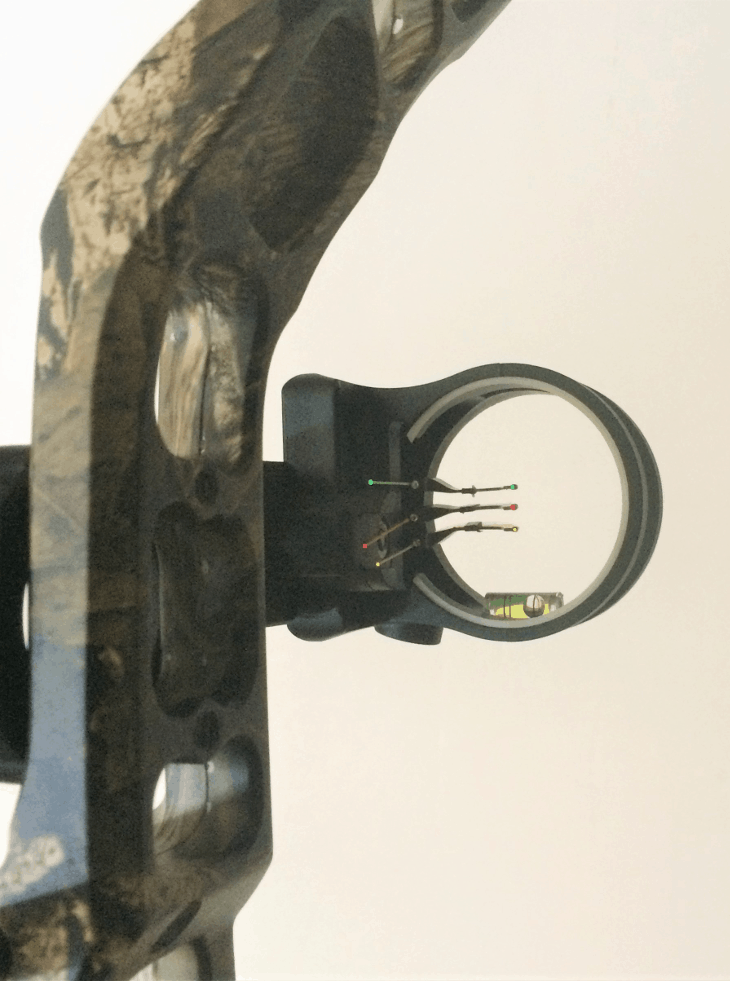
Single pin sights are a little bit different—they have only one pin, and you set it for a target at an exact distance: if you’re shooting at a target 18 yards away, you’d set it for 18 yards; if you were shooting at a target 27 yards away, you’d set it for 27 yards.
Compound bows—particularly beginner compound bows—very often feature a fixed pin bow sight that comes with the bow, and that’s a good thing: fixed pin sights are a great way to learn how to aim. Single pins are precision tools, and while they’re great to use—and great for hunters—they don’t really teach you how to aim!
The Peep Sight
The peep sight is a small plastic ring that you slip it between the strands of your bowstring to enhance your aim. When it’s set up properly, you can look through the peep sight on your bow string, and then through the sight itself, to line up your shots and have more accuracy and consistency.
In the image below, there’s a peep sight on the woman’s string riiiiiiight in front of her eye (we’ve added a blue dot right in front of it), and she’s looking through the peep sight on the string, and the through the sight attached to her riser. Lining up the peep sight and the sight and then aiming at your target can dramatically increase your accuracy.
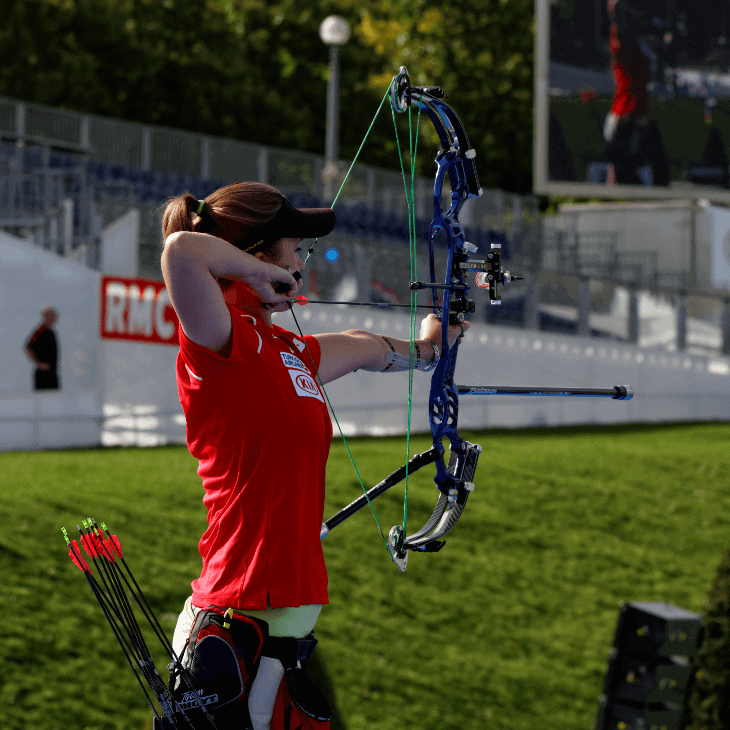
A D-Loop
The D-loop is attached to the bowstring and is a small piece of very strong string in the shape of a “D.” When wearing a release aid, you hook the release aid into the loop of the D to pull the bow string back.
A Release Aid
Technically, a release aid isn’t part of a compound bow, but most archers use one with a compound, so we should discuss them. Most compound bow shooters don’t draw the bow string with their fingers, and instead use a release aid to pull the string when drawing. The bow strings on compounds tend to be VERY strong, and a release aid can make it a lot easier to draw.
There are a couple different types of release aids, but the most popular—and perhaps best—for new compound bow archers is the wrist strap, aka the index finger release. It looks like this:
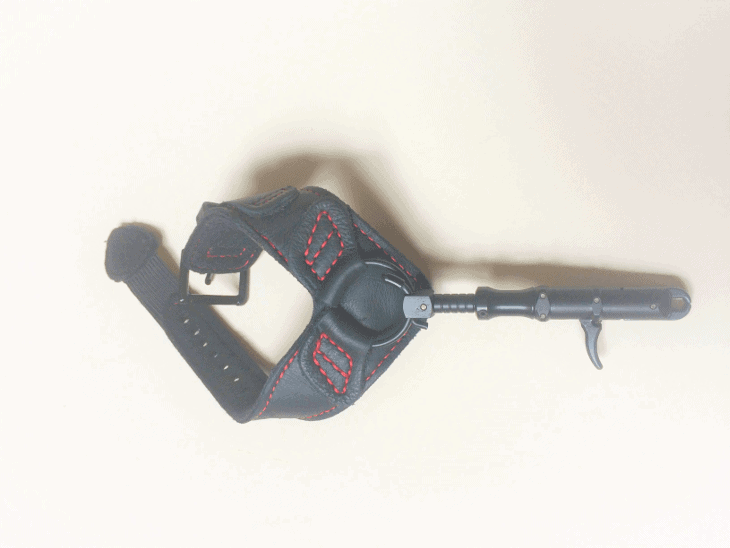
The strap goes around your wrist, and you attach the caliper—those two hook-looking pieces at the end—to the D loop. Pull the bow string back to full draw, and when you’re ready to release an arrow, you pull the trigger. It’s VERY, VERY important to keep your trigger finger BEHIND the trigger when you draw, because keeping your trigger finger ON the trigger makes it very likely you’re going to release an arrow before you’re ready, and that is incredibly dangerous. Draw, aim, put your finger on the trigger, and then release.
By the way, if you’re looking for a release aid, we like the TruFire Edge Release:
- FOLDBACK BUCKLE LEATHER STRAP – for hands free operation, giving you the ability to secure to wrist with one hand and glass, climb, or rattle with no flopping or clanging
- PERFECT FOR EVERY HAND – Length adjustment with locking option and ADJUSTABLE TRIGGER TRAVEL for a custom fit on either right or left hand
- RUGGED AND COMPACT – Extremely durable jaws with a dime sized head
sturdy, reliable, and with a wide range of adjustability.
There are other types of release aids—thumb releases, hinge releases, and resistance activated releases—but those are mostly for intermediate archers, so we’ll those be for now.
A release aid connects to the D-loop on the bowstring and is what you can use to let go of the bowstring, instead of your fingers. Now that you know what a release aid with those calipers at the front looks like, here’s the D loop you connect it to—it’s that grey piece loop on the bow string:
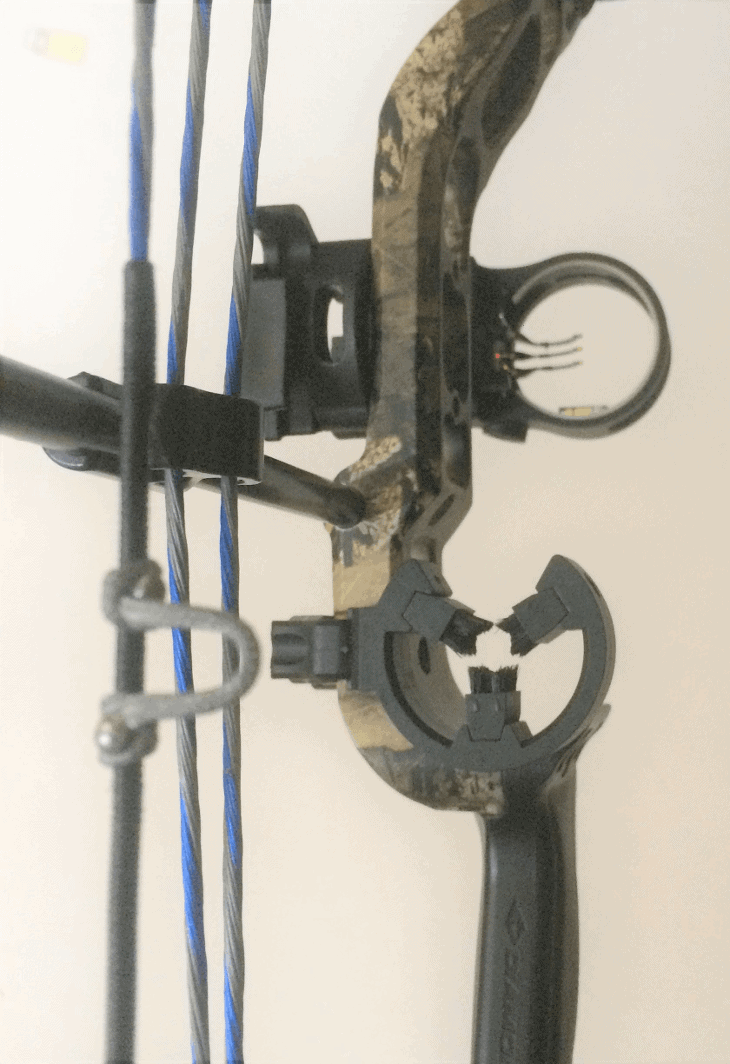
A Bow Stabilizer
A stabilizer sticks out perpendicular to the riser, and it’s got two functions: to eat up some of the vibration in the bow after you release an arrow (and therefore make the shot a little quieter—a very important feature for bowhunters) and to provide a little “balance” to the bow. Stabilizers for compound bows tend to be anywhere from four to twelve inches, whereas on recurves, they can be anywhere from 10 to 30+ inches.
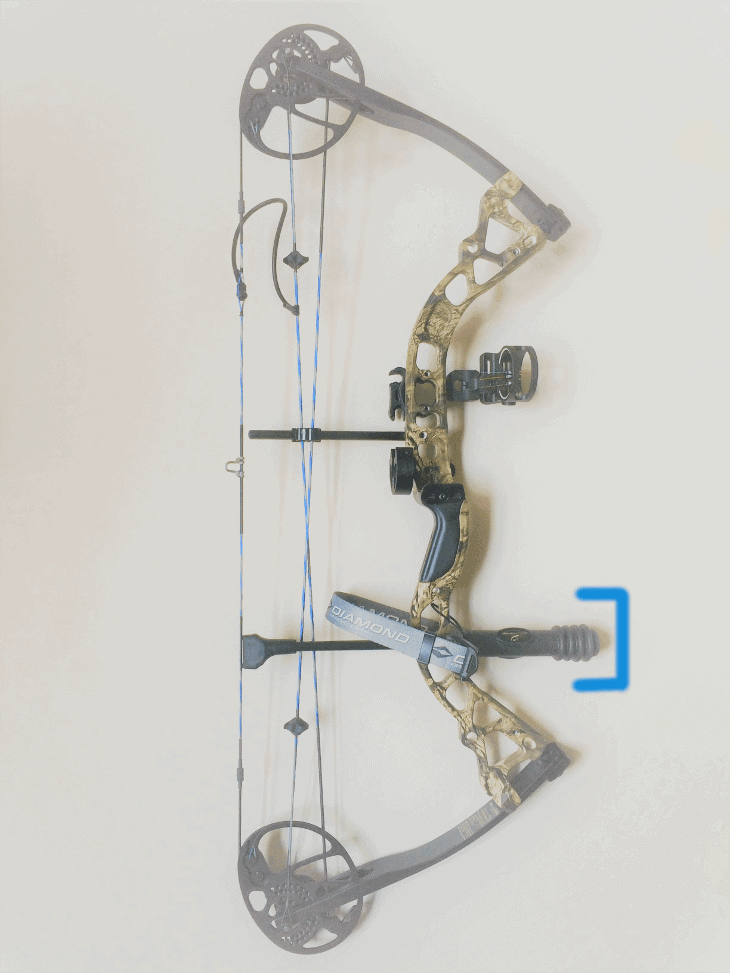
Whether you use a stabilizer or not is a matter of personal preference. Some people find that the rods help improve their aim and their shots. Others don’t notice any difference between shooting with a bow with a stabilizer and one without a stabilizer.
A Sling / Wrist Sling
A sling is attached to the riser of the bow, and it slips around your wrist to help you maintain control of the bow during and after a shot. Without a sling, it’s very possible to let go of the bow after shooting, and it’s definitely “best practices” to shoot with a sling. The wrist sling is that grey piece of material right below the grip:
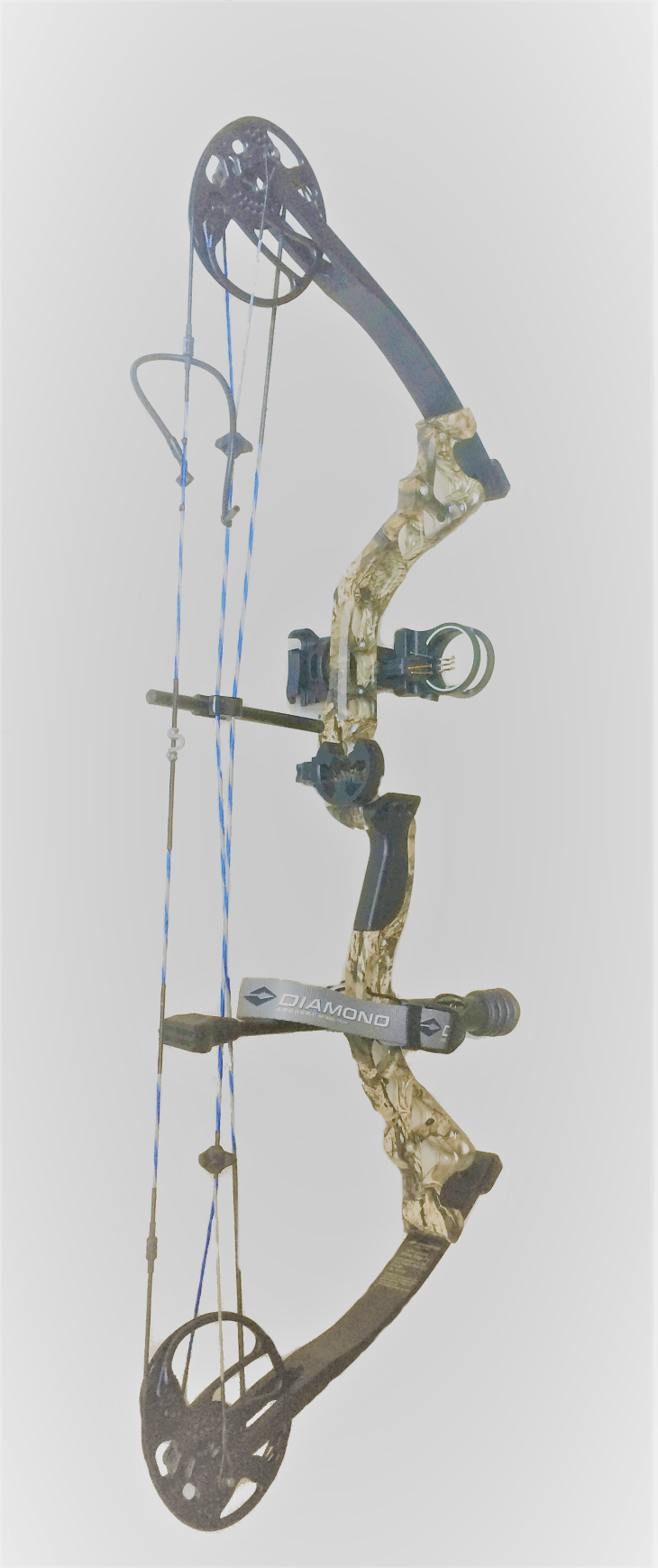
Let-Off
We mentioned this earlier, and while it’s not a part of a compound bow—it’s more of a feature—it’s important to mention.
When you draw a bow, the bow string provides resistance. A low-poundage bow will be easy to draw, and a high-poundage bow will be difficult to draw. On a compound bow, you’ll find that after a certain point in the draw, it’s a LOT easier to hold the string back. You’re pulling and it’s heavy and you’re pulling and it’s heavy and then all of sudden, it’s very easy to keep the bow string held back. That spot where it’s easy to hold the bow string back is the “let-off.”
It’s the place in the draw where pulling the bow string back becomes a LOT easier. That’s a function of the cams on a compound bow—there’s no “let-off” on a recurve bow—and it’s great for hunting, because you can draw and aim for quite some time without getting tired, but it’s great for target shooting, too.
Let-off is often measured in percentages, and if you had a bow with a 100-pound draw weight—a ridiculously heavy bow, that we’re just using as an example—and it had an 80% let-off, when you pulled the bow all the way back, it would feel like you were only pulling back 20 pounds. Let-off is an incredible feature, and it’s an important aspect of compound bows.
And… those are all the major parts of a compound bow! Congratulations—if you’re still here and you’re still reading, you’ve gone from “total newbie” to “advanced beginner.” Good job!
Other Bow Features Worth Noting
There are two other features you may want to consider when getting your first bow. They’re secondary features, but we get a lot of questions about them, so we’d figured we mention them. They are:
Bow Weight
If the draw weight of the bow is the amount of weight you have to deal with when you pull back on the bowstring, the bow weight is simply the weight of the bow itself. Luckily, in the grand scheme of things, compound bows don’t vary too much when it comes to overall weight, and you’re likely to find a bow that most bows weigh somewhere between 3 and 4.5 pounds (although a very short or very long bow might weigh a bit less or more).
Although it might not seem as if there’s too great of a difference between a bow that’s 3 pounds and a bow that’s 4.5 pounds, after an afternoon at the range, that weight can be quite noticeable. There are also slight performance differences—lighter bows are great to lug around (great for hunting) but can be noisier and “jumpier” on the shot, whereas heavier bows can be very stable—but make your arm feel like it’s going to fall off.
Honestly, with just about everything related to archery, it’s a trade-off, and you’ll figure out what you really need through practice and experience.
Arrow Speed in FPS
Speed is always one of the primary specs archers talk about with everyone always on the hunt for a faster bow. As a general rule of thumb, a slow bow is one that shoots less than 300 feet-per-second (FPS) while a fast bow is one that shoots at least 340 fps.
Many archers prefer fast bows because a greater speed means greater power behind the shot. It also increases the distance the arrow flies before it starts to drop which provides for better accuracy over a longer range, especially important for bowhunting. For target shooting, speed isn’t quite as important, but it can still improve accuracy and just be overall more fun to shoot.
On the other hand, high speed bows usually have higher draw weights and can be harder to handle for beginners. We recommend paying closer attention to the draw weight and worrying about speed when you have a bit more experience, but if you’re going to be bowhunting, feel free to look for the fastest bow you think you can handle accurately.
Frequently Asked Questions
We get a lot of questions from new archers, and we’ve tackled most of them in the sections above, but here are few other random ones we get, with the first one the most common:
Q: Can my kid shoot archery?
A: Absolutely! BUT. And this is a big but: the decision to let your kids do archery is a parenting decision that you need to make, and if you’ve got a spouse, you and your spouse need to make together. There are kids all around the world who do archery—it’s been an integral part of Boy Scouts and Girls Scouts training for decades—and it can be a great parent/child bonding activity. A lot of kids seem to love it, and it can also be a great way to teach them about nature and the outdoors.
THAT SAID—and we can’t stress this strongly enough—archery is a sport that, without proper supervision, can be incredibly dangerous. If you make the decision that your child can do archery, you need to provide proper supervision to ensure they don’t get hurt. If you’re not going to provide supervision and make sure they’re safe, don’t get them involved in archery.
The next question we get a lot:
Q: Is there a difference between a men’s compound bow and a women’s compound bow?
A: Not really. All compound bows, regardless of gender, are built the same and function in the same way. However, women usually need smaller bows, both in draw length and weight, so keep that in mind.
Q: Aren’t compound bow used only for hunting?
A: No way! There are plenty of archers who use compound bows who are interested in target archery, and have no interest in bowhunting. There are compound target competitions all over the country, and they’re a lot of fun. Please don’t think that compound bows are only used for hunting—that’s absolutely not true at all.
Q: Can I go hunting with a compound bow?
A: Yes, and in fact, we’ll say that most bowhunters use a compound bow to go hunting. There’s good reason for that—compound bows are fast and powerful and they’re much easier to aim and use than recurve bows. For a lot of people—most, we’d even say—it’s a much, much better idea to use a compound bow when you’re hunting.
If you do decide to go hunting, make sure you’re following state and local bowhunting laws—many states have a requirement about how heavy your draw weight must be (usually it’s 40 pounds, but every state legislates requirements differently) and the dates during which you can hunt, so make sure you’re “up to code,” as they say. If you call your state’s department of game and wildlife, they’ll usually be able to steer you in the right direction.
Q: Is a compound bow better than a recurve?
A. There’s no “better,” really—there are different bows for different purposes. Compound bows are usually more powerful and faster and they have the “let-off” we discussed above, and that makes them a go-to for hunters, but recurve bows are easier to take care of, and most target competitions require you to use a recurve. One isn’t better than the other—they’re both great, and you’ll find that the more you love archery, the more you may want to shoot with both of them.
Q: Why is your website so fantastic and amazing?
A: You’re too kind! We put a lot of work into it, and we’re really passionate about the sport. It’s our pleasure!
Our Final Thoughts
Learning to shoot a compound bow is a great way to get outside and see nature. You can enjoy this sport with your kids, or you can hone your skills and head out to hunt. Regardless of why you chose to explore archery, outfitting yourself with a high-quality compound bow is critical to your success. We have covered a wide range of affordable options for users of all ages and sizes.
While you can buy a compound bow on its own, you can save money and hassle by purchasing a kit. This will give you complimentary accessories such as arrows, a quiver, or even a stabilizer depending on the make and model. There are even creative color options and attractive designs that will fit just about any aesthetic.
If you are new to the world of archery, we are glad to have you. A lot of great names have helped bring the spotlight to the sport, and there are many more fantastic archers that help further the love of archery outside of competition. We hope you have enjoyed the information we have to offer and wish you all the best on your journey to becoming an archer through dedicated growth and development. We also hope that our suggestions have helped you choose the best beginner compound bow that meets your needs. Take care until next time!

